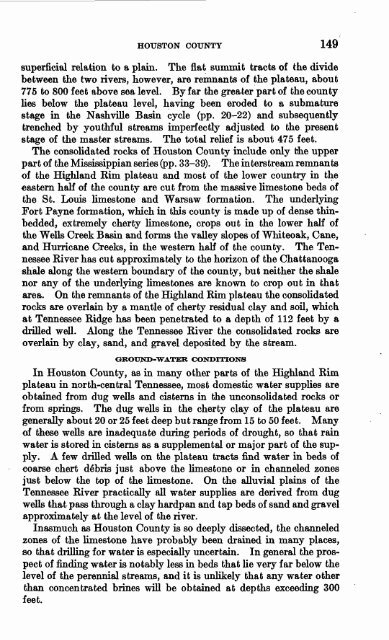GROUND WATER IN NORTH-CENTRAL TENNESSEE
GROUND WATER IN NORTH-CENTRAL TENNESSEE
GROUND WATER IN NORTH-CENTRAL TENNESSEE
Create successful ePaper yourself
Turn your PDF publications into a flip-book with our unique Google optimized e-Paper software.
HOUSTON COUNTY 149<br />
superficial relation to a plain. The flab summit tracts of the divide<br />
between the two rivers, however, are remnants of the plateau, about<br />
775 to 800 feet above sea level. By far the greater part of the county<br />
lies below the plateau level, having been eroded to a submature<br />
stage in the Nashville Basin cycle (pp. 20-22) and subsequently<br />
trenched by youthful streams imperfectly adjusted to the present<br />
stage of the master streams. The total relief is about 475 feet.<br />
The consolidated rocks of Houston County include only the upper<br />
part of the Mississippian series (pp. 33-39). The interstream remnants<br />
of the Highland Eim plateau and most of the lower country in the<br />
eastern half of the county are cut from the massive limestone beds of<br />
the St. Louis limestone and Warsaw formation. The underlying<br />
Fort Payne formation, which in this county is made up of dense thin-<br />
bedded, extremely cherty limestone, crops out in the lower half of<br />
the Wells Creek Basin and forms the valley slopes of Whiteoak, Cane,<br />
and Hurricane Creeks, in the western half of the county. The Ten<br />
nessee River has cut approximately to the horizon of the Chattanooga<br />
shale along the western boundary of the county, but neither the shale<br />
nor any of the underlying limestones are known to crop out in that<br />
area. On the remnants of the Highland Rim plateau the consolidated<br />
rocks are overlain by a mantle of cherty residual clay and soil, which<br />
at Tennessee Ridge has been penetrated to a depth of 112 feet by a<br />
drilled well. Along the Tennessee River the consolidated rocks are<br />
overlain by clay, sand, and gravel deposited by the stream.<br />
<strong>GROUND</strong>-<strong>WATER</strong> CONTHTIONS<br />
In Houston County, as in many other parts of the Highland Rim<br />
plateau in north-central Tennessee, most domestic water supplies are<br />
obtained from dug wells and cisterns in the unconsolidated rocks or<br />
from springs. The dug wells in the cherty clay of the plateau are<br />
generally about 20 or 25 feet deep but range from 15 to 50 feet. Many<br />
of these wells are inadequate during periods of drought, so that rain<br />
water is stored in cisterns as a supplemental or major part of the sup<br />
ply. A few drilled wells on the plateau tracts find water in beds of<br />
coarse chert debris just above the limestone or in channeled zones<br />
just below the top of the limestone. On the alluvial plains of the<br />
Tennessee River practically all water supplies are derived from dug<br />
wells that pass through a clay hardpan and tap beds of sand and gravel<br />
approximately at the level of the river.<br />
Inasmuch as Houston County is so deeply dissected, the channeled<br />
zones of the limestone have probably been drained in many places,<br />
so that drilling for water is especially uncertain. In general the pros<br />
pect of finding water is notably less in beds that lie very far below the<br />
level of the perennial streams, and it is unlikely that any water other<br />
than concentrated brines will be obtained at depths exceeding 300<br />
feet.

















